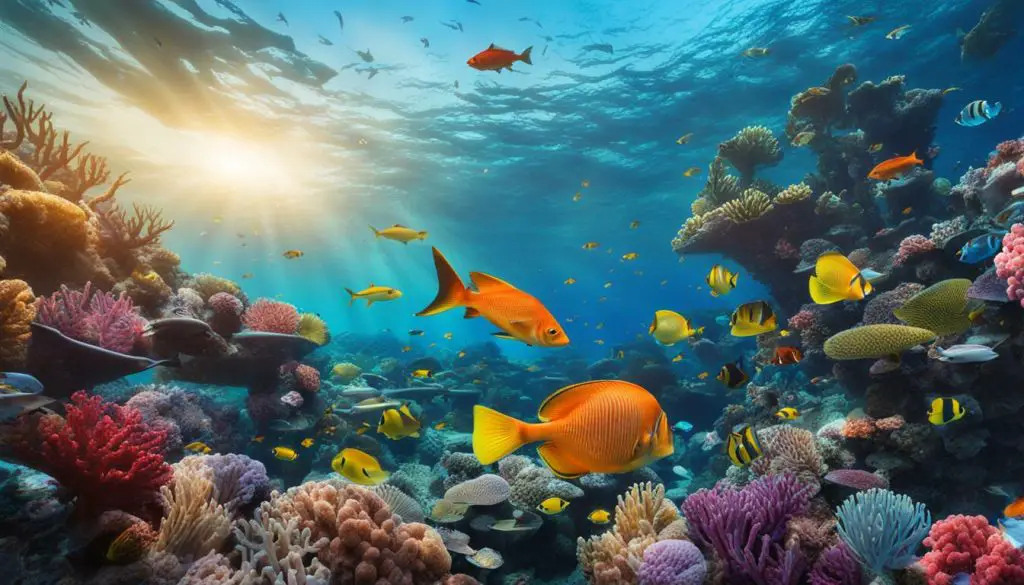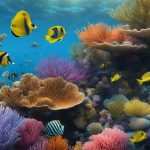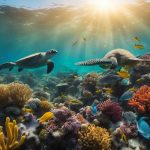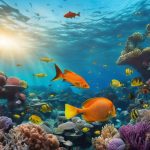Marine conservation areas are protected ocean spaces designated to preserve marine environments and their inhabitants. These areas are established to help regulate human activities and promote sustainable practices that maintain the health and productivity of ocean ecosystems.
Marine conservation areas play a crucial role in preserving marine biodiversity and protecting vulnerable species. By designating specific areas for conservation, we can limit human impact on the ocean environment, reduce overfishing, and protect habitats that are essential for the survival of various marine species.
Understanding what are marine conservation areas and their significance is essential for the protection of our oceans. In this guide, we will explore the importance of marine conservation areas, their benefits, and the various strategies and challenges involved in marine conservation efforts.

Key Takeaways
- Marine conservation areas are established to protect ocean environments and their inhabitants
- These areas promote sustainable practices that maintain the health and productivity of ocean ecosystems
- Marine conservation areas are crucial for preserving marine biodiversity and protecting vulnerable species
- Limiting human impact on the ocean environment, reducing overfishing and protecting habitats are key benefits of marine conservation areas
- Understanding marine conservation areas and their significance is essential for the protection of our oceans
Importance of Marine Conservation Areas
Marine conservation areas play a critical role in preserving the world's marine ecosystems and their biodiversity. These areas provide protection to marine species, ecosystems, and habitats, helping to maintain the delicate balance of the ocean's natural systems.
Marine biodiversity refers to the variety of life forms and ecosystems found within the ocean. It includes everything from tiny plankton to large marine mammals and everything in between. Marine biodiversity is crucial to the health and well-being of our planet, providing vital ecosystem services such as food, oxygen production, and climate regulation.
Conservation efforts in marine areas aim to preserve the biodiversity of species within the ocean and maintain the proper functioning of marine ecosystems. This helps to ensure the sustainability of fisheries and marine resources, as well as the overall health of the ocean and its ecosystems.
Marine Species Conservation
Marine conservation areas also play an important role in protecting threatened marine species. Many marine species, including whales, sharks, and sea turtles, are at risk of extinction due to overfishing, habitat destruction, and other human-induced pressures.
Marine conservation efforts help to protect these vulnerable species by providing safe havens for them to breed, feed, and rest. These areas can also help to reduce the impacts of fisheries by limiting the number of fishing boats and tools, as well as the catch and bycatch.
Benefits of Marine Conservation Areas
The benefits of marine conservation areas go beyond protecting marine species and their habitats. They also contribute to the overall health of the ocean and promote sustainable management practices.
Conservation areas can help to maintain the natural functioning of marine ecosystems, providing important services such as carbon sequestration and water filtration. They can also support sustainable fisheries by providing areas for fish to breed and grow.
Furthermore, marine conservation areas are essential for the promotion of sustainable management practices. By limiting human activities such as fishing, mining, and development in certain areas, these areas can help to ensure that the ocean's ecosystems are managed in a way that is both environmentally and economically sustainable.
In conclusion, the importance of marine conservation areas cannot be overstated. Through their protection of marine species, ecosystems, and habitats, these areas are essential for maintaining the health and sustainability of the world's oceans. By working together to support and promote marine conservation efforts, we can help to ensure that future generations can continue to enjoy the many benefits provided by our oceans.
Benefits of Marine Conservation Areas
Marine conservation areas provide a range of benefits for both marine species and humans. One of the key benefits is the preservation of marine ecosystems, which in turn supports the sustainability of marine resources. By limiting human activity in designated areas, marine ecosystems are protected from habitat destruction and overfishing, allowing them to recover and regenerate.
In addition to promoting marine ecosystem preservation, conservation areas also facilitate sustainable marine management. This involves the responsible use of marine resources, such as through regulated fishing practices and limiting pollution. Sustainable marine management practices ensure that marine resources are used in a way that supports long-term viability and productivity.
Conservation areas also provide opportunities for scientific research and educational initiatives, allowing us to learn more about the marine environment and develop new strategies for conservation efforts. This knowledge can be used to inform policy and management decisions, and to raise awareness about the importance of marine conservation.
Another important benefit of marine conservation areas is the economic value they provide. By supporting sustainable fishing and tourism activities, marine conservation areas can create jobs and generate revenue for local communities. This economic value not only supports the livelihoods of local residents, but also provides an incentive for the continued protection and preservation of these areas.
Overall, marine conservation areas play a crucial role in preserving marine ecosystems, promoting sustainable management practices, and providing economic and educational benefits. By recognizing the value of these areas and supporting their conservation efforts, we can ensure the continued health and productivity of our oceans for generations to come.
Understanding Marine Protected Areas
Marine protected areas (MPAs) are designated zones within oceans, seas, or coastal areas that have legal protection to conserve and manage marine habitats, ecosystems, and species. These protected areas can take various forms, such as national parks, marine reserves, or sanctuaries.
The primary purpose of MPAs is to preserve and protect important marine habitats and the species they support. By designating certain areas as protected, they limit or prohibit human activities that may harm the environment, such as fishing, mining, or oil exploration. This ensures that marine ecosystems can thrive, and vulnerable species can recover and reproduce.
Understanding Marine Habitat Preservation
Marine protected areas play a crucial role in preserving marine habitats, which are critical for the health and survival of marine species. These habitats include coral reefs, seagrass meadows, and kelp forests, among others. By protecting these habitats, MPAs help to maintain the balance and productivity of marine ecosystems.
In addition, MPAs can serve as important sites for scientific research and monitoring, providing insights into the behavior and health of marine species and their habitats. This information can guide conservation efforts and inform policy decisions related to marine resource management.
The Role of Marine Conservation in Preserving Biodiversity
Marine conservation strategies are essential for protecting marine biodiversity, which refers to the variety of life in the ocean. The ocean is home to an estimated 700,000 to one million species, including fish, mammals, reptiles, and invertebrates. Many of these species are unique to the ocean and play crucial roles in maintaining the health and productivity of marine ecosystems.
Marine conservation efforts focus on preserving biodiversity by protecting habitats, managing resources sustainably, and preventing overfishing and other destructive practices. One important approach is the establishment of marine protected areas, which restrict human activities in specific areas to conserve important habitats and species.
Another conservation strategy is promoting sustainable fishing practices, such as implementing fishing quotas and using selective fishing gear. These practices prevent overfishing and protect important species, such as tuna and sharks, from being overexploited.
Marine conservation also involves addressing broader issues, such as climate change and pollution, which threaten marine biodiversity. Strategies for mitigating the impacts of climate change on marine ecosystems include reducing greenhouse gas emissions and increasing the resilience of coral reefs and other vulnerable habitats.
Pollution, such as plastic waste and oil spills, can have devastating effects on marine life and ecosystems. Marine conservation efforts aim to reduce pollution through better waste management, conservation education, and enforcement of laws and regulations.
Overall, marine conservation is critical for maintaining the health and productivity of marine ecosystems and preserving the rich biodiversity of the ocean. Through effective conservation strategies and collaboration among stakeholders, we can ensure the sustainability of marine resources for future generations.
Conservation Efforts for Threatened Marine Species
In recent years, there has been growing concern over the decline of marine species due to various human activities such as overfishing, habitat destruction, and pollution. To address this issue, marine conservation efforts have increasingly focused on the preservation and protection of vulnerable species.
Marine species conservation involves a range of strategies and measures aimed at preserving threatened species and their habitats. One of the most effective strategies is the establishment of marine protected areas, which serve as sanctuaries for vulnerable species to breed and thrive.
Conservation Efforts for Threatened Marine Species
Marine conservation efforts for threatened species also involve monitoring populations, implementing fishing restrictions and quotas, and reducing pollutants that harm marine life. For example, many conservation efforts have been focused on protecting sea turtles, sharks, and whales, which have faced significant population declines over the years.
Beyond these species-specific conservation efforts, there are broader strategies aimed at preserving marine biodiversity as a whole. These include reducing greenhouse gas emissions and other pollutants that contribute to ocean acidification and affect the health of marine ecosystems.
The Importance of Marine Biodiversity
Marine biodiversity is critical for sustaining healthy oceans and for providing essential ecosystem services such as food, oxygen production, and carbon sequestration. Losing species at a rapid rate can lead to cascading effects in the ecosystem, which can ultimately affect human wellbeing.
Therefore, protecting marine species and their habitats is crucial for maintaining a healthy and productive ocean for future generations. By implementing effective conservation strategies and working collaboratively, we can ensure the preservation of marine biodiversity and the continued health of our oceans.
The Role of Sustainable Management in Marine Conservation
Effective management of marine resources is critical to the preservation of marine ecosystems and species. Sustainable marine management is an approach that seeks to ensure the long-term health and productivity of our oceans while meeting the needs of present and future generations.
Sustainable management practices involve the integration of environmental, social, and economic considerations in decision-making processes. This approach recognizes the importance of maintaining the balance between conservation and utilization of marine resources.
One of the key principles of sustainable marine management is the precautionary approach, which calls for proactive measures to prevent harm to the environment and its biodiversity. This involves the careful consideration of potential impacts and the implementation of measures to minimize or avoid these impacts.
Another important aspect of sustainable marine management is the use of science-based approaches to inform decision-making processes. This involves the collection and analysis of data on marine ecosystems and species, which is then used to guide conservation efforts and management decisions.
Effective sustainable management practices also involve the involvement of various stakeholders, including governments, NGOs, local communities, and the private sector. Collaboration and cooperation among these stakeholders are critical to the success of marine conservation efforts.
Overall, sustainable management practices play a critical role in marine conservation. By promoting responsible and proactive approaches to the use and protection of marine resources, we can ensure the long-term health and sustainability of our oceans and the species that call them home.
The Role of Stakeholders in Marine Conservation
Marine conservation strategies must involve the participation of various stakeholders to ensure the effective management and sustainable use of marine resources. These stakeholders include governments, NGOs, local communities, researchers, and the fishing industry.
The sustainable management of marine resources, which is crucial for the conservation of marine ecosystems, often requires complex decision-making processes that involve balancing economic, social, and environmental considerations. Therefore, the involvement of a wide range of stakeholders is necessary for the development and implementation of effective conservation strategies.
Governments play an essential role in marine conservation through the development of policies and regulations that promote sustainable marine management. NGOs and local communities also contribute to marine conservation efforts by raising awareness, advocating for policy change, and implementing conservation projects.
Research institutions are essential for providing the scientific knowledge needed for evidence-based decision making. The fishing industry, too, can play a significant role in marine conservation by adopting sustainable fishing practices, investing in research, and participating in conservation initiatives.
The collaboration and cooperation of these stakeholders are crucial for the success of marine conservation efforts. By working together, they can develop and implement effective strategies that promote the sustainable use of marine resources and protect the health and productivity of marine ecosystems for future generations.
Challenges in Marine Conservation
The preservation of marine ecosystems and species is a critical issue facing our planet today. However, conservation efforts are met with a wide range of challenges that require proactive and adaptive strategies to overcome.
One of the biggest challenges facing marine conservation strategies is climate change. The rise in sea temperatures, ocean acidification, and extreme weather events have a profound impact on marine ecosystems, leading to the loss of biodiversity and the alteration of habitats.
Another significant challenge is pollution, which can come from various sources such as oil spills, plastic debris, and chemical run-off. These pollutants have serious consequences for marine life, leading to health problems and disruptions to entire food chains.
Overfishing is also a major threat to marine ecosystems and biodiversity. Unsustainable practices, such as the use of destructive fishing methods and excessive harvesting, can result in the depletion of fish stocks and the disturbance of marine habitats.
Habitat destruction is yet another challenge that marine conservation efforts must address. Dredging, coastal development, and land reclamation projects can all have devastating effects on marine ecosystems and the species that depend on them.
Overall, the complexities of marine conservation require a multifaceted approach that involves the collaboration of various stakeholders. By working together to address these challenges and implement sustainable management practices, we can ensure the long-term health and productivity of our marine ecosystems.
Success Stories in Marine Conservation
Effective marine conservation strategies are crucial for preserving the biodiversity and sustainability of our oceans. Here are some inspiring success stories in marine conservation:
1. Chagos Marine Reserve
The Chagos Archipelago, located in the Indian Ocean, is home to some of the world's most pristine coral reefs. In 2010, the UK government established the Chagos Marine Reserve, which encompasses over 250,000 square miles of ocean – making it the largest fully protected marine reserve in the world. The reserve is managed by the Chagos Conservation Trust and provides a sanctuary for a wide range of marine species, including sharks, turtles, and over 220 species of coral.
2. VaquitaCPR
The vaquita, a small porpoise found only in the Gulf of California, is one of the world's most endangered marine mammals, with only around 10 individuals remaining in the wild. To try and save this species from extinction, the Mexican government, along with international partners, launched the VaquitaCPR project in 2017. The project involved capturing the remaining vaquitas and placing them in a temporary sea pen to protect them from illegal fishing activity. While the project was ultimately unsuccessful in saving the species, it demonstrated the importance of international collaboration and proactive conservation measures.
3. The Great Barrier Reef Marine Park
The Great Barrier Reef is one of the most iconic and important marine ecosystems in the world. In 1975, the Australian government established the Great Barrier Reef Marine Park, which spans over 133,000 square miles and is home to thousands of marine species. The park is managed using a combination of zoning, regulation, and conservation efforts to ensure the continued health and sustainability of the reef. Despite ongoing threats such as climate change and pollution, the Great Barrier Reef Marine Park remains a critical success story in marine conservation.
4. The Monterey Bay Aquarium Seafood Watch Program
One of the biggest threats to marine biodiversity is unsustainable fishing practices. The Monterey Bay Aquarium Seafood Watch Program aims to address this issue by providing consumers, chefs, and businesses with information on which seafood options are sustainable and which should be avoided. The program has been incredibly successful, with over 1.5 million people using its resources to make informed seafood choices and promoting sustainable fishing practices around the world.
5. The Revillagigedo Archipelago National Park
The Revillagigedo Archipelago, located off the coast of Mexico, is a critical habitat for a wide range of marine species, including sharks, whales, and sea turtles. In 2017, the Mexican government declared the area a national park, granting it full protection and banning all extractive activities, including fishing and mining. The park is managed by a coalition of government agencies, NGOs, and local communities, and serves as a model for effective marine conservation efforts around the world.
These success stories demonstrate that with effective marine conservation strategies, we can protect and preserve our oceans for future generations.
Conclusion
Marine conservation areas play a crucial role in the preservation and protection of our marine ecosystems and biodiversity. Through the establishment of marine protected areas and the implementation of sustainable management practices, we can ensure the long-term health and productivity of our oceans.
The challenges faced in marine conservation, such as climate change, pollution, overfishing, and habitat destruction, require proactive and adaptive conservation strategies to mitigate their impact. Collaboration between various stakeholders, including governments, NGOs, and local communities, is key to achieving effective conservation outcomes.
Protecting Our Marine Ecosystems
By safeguarding our marine conservation areas, we can preserve the unique and diverse habitats and species that depend on them. Success stories in marine conservation, such as the recovery of the humpback whale and the protection of coral reefs, demonstrate the positive impact of effective conservation strategies.
It is our responsibility to take action and protect our marine biodiversity for future generations. By supporting and advocating for marine conservation areas, we can ensure that our oceans continue to thrive and provide essential benefits to our planet.
Thank you for reading this guide on what are marine conservation areas. Let us continue to work together towards the preservation and protection of our marine ecosystems.
FAQ
What are marine conservation areas?
Marine conservation areas are designated areas in protected waters that aim to conserve and preserve marine ecosystems, habitats, and species. These areas are established to safeguard the biodiversity and health of marine environments.
Why are marine conservation areas important?
Marine conservation areas play a vital role in protecting marine biodiversity and promoting the sustainable management of marine resources. They help prevent habitat destruction, preserve vulnerable species, and maintain the overall health and functioning of marine ecosystems.
What are the benefits of marine conservation areas?
Marine conservation areas provide several benefits, including the preservation of marine ecosystems, the promotion of sustainable marine management practices, and the safeguarding of important habitats for marine species. They also contribute to scientific research and education, as well as the promotion of eco-tourism and recreational activities.
What are marine protected areas?
Marine protected areas are specific types of marine conservation areas that are established to provide extra protection to specific habitats, species, or ecosystems. They often have stricter regulations and management measures in place to ensure the preservation of these sensitive areas.
How does marine conservation help preserve biodiversity?
Marine conservation employs various strategies such as the establishment of protected areas, the implementation of sustainable fishing practices, and the reduction of pollution to preserve marine biodiversity. These efforts aim to protect vulnerable species, maintain healthy ecosystems, and mitigate the impacts of human activities on marine habitats.
What conservation efforts are in place for threatened marine species?
Conservation efforts for threatened marine species include the implementation of fishing quotas and bans, the establishment of protected areas specifically targeting these species, and the enforcement of regulations to prevent illegal trade and poaching. Collaborative research, monitoring, and public awareness campaigns also play a crucial role in their conservation.
How is sustainable management of marine resources achieved?
Sustainable management of marine resources involves the use of responsible fishing practices, the protection of important habitats, the reduction of pollution and waste, and the promotion of eco-friendly tourism. It requires a balanced approach that considers the long-term health and productivity of marine ecosystems while meeting the needs of human populations.
What is the role of stakeholders in marine conservation?
Stakeholders, such as governments, NGOs, scientists, local communities, and industry sectors, play a crucial role in marine conservation. Their collaboration is essential for developing and implementing effective conservation strategies, ensuring the sustainable management of marine resources, and raising awareness about the importance of marine ecosystems.
What are the challenges in marine conservation?
Marine conservation faces challenges such as climate change, pollution, overfishing, habitat destruction, and invasive species. These challenges require proactive and adaptive conservation strategies that address the root causes and aim to mitigate their impacts on marine ecosystems.
Can you provide some success stories in marine conservation?
There are numerous success stories in marine conservation that highlight the positive impact of effective strategies. Examples include the recovery of endangered species like sea turtles and the restoration of damaged coral reefs through conservation efforts focused on habitat protection, fishing restrictions, and community engagement. These success stories demonstrate the potential for positive change and the importance of continued conservation efforts.
Latest Posts
- Royal Windermere Yacht Club Review
 Did you know Lake Windermere is England's biggest lake? It's 10.5 miles long and 1 mile wide. This beautiful lake is home to the famous Royal Windermere Yacht Club. It's one of the UK's top sailing clubs, making it a great spot for sailing fans and those who love being on the water. The Royal… Read more: Royal Windermere Yacht Club Review
Did you know Lake Windermere is England's biggest lake? It's 10.5 miles long and 1 mile wide. This beautiful lake is home to the famous Royal Windermere Yacht Club. It's one of the UK's top sailing clubs, making it a great spot for sailing fans and those who love being on the water. The Royal… Read more: Royal Windermere Yacht Club Review - Coquet Yacht Club Review
 Welcome to the Coquet Yacht Club in Amble, UK. It's known for its yachting community and great marina. Also, see why this club is so well-loved. The Coquet Yacht Club has over 500 members who love boating. They come from many different backgrounds but share a passion for sailing. This club has a long history… Read more: Coquet Yacht Club Review
Welcome to the Coquet Yacht Club in Amble, UK. It's known for its yachting community and great marina. Also, see why this club is so well-loved. The Coquet Yacht Club has over 500 members who love boating. They come from many different backgrounds but share a passion for sailing. This club has a long history… Read more: Coquet Yacht Club Review - Coniston Sailing Club Review
 Did you know about the Coniston Sailing Club in the stunning Lake District? It offers many services and activities for all sailing lovers. The club's beautiful location and great facilities make it a top pick for sailing in the UK. At Coniston Sailing Club, you can learn to sail, hire a boat, or join fun… Read more: Coniston Sailing Club Review
Did you know about the Coniston Sailing Club in the stunning Lake District? It offers many services and activities for all sailing lovers. The club's beautiful location and great facilities make it a top pick for sailing in the UK. At Coniston Sailing Club, you can learn to sail, hire a boat, or join fun… Read more: Coniston Sailing Club Review - St Andrews Sailing Club Review
 Did you know sailing is growing fast in the UK? More people are discovering the joy of sailing. If you love sailing or want to learn, check out St Andrews Sailing Club. The club has something for everyone. From beginners to experts, you can learn and have fun. Their instructors teach you everything about sailing… Read more: St Andrews Sailing Club Review
Did you know sailing is growing fast in the UK? More people are discovering the joy of sailing. If you love sailing or want to learn, check out St Andrews Sailing Club. The club has something for everyone. From beginners to experts, you can learn and have fun. Their instructors teach you everything about sailing… Read more: St Andrews Sailing Club Review - Derwent Reservoir Sailing Club Review
 Did you know that Derwent Reservoir in Northumberland is famous for both calm walks and exciting water sports? The Derwent Reservoir Sailing Club is loved by many. Families, water sports fans, and those who love adventure come here. The club is in Blanchland, Consett, a nice place for all. Imagine paddle boarding, dinghy sailing, windsurfing,… Read more: Derwent Reservoir Sailing Club Review
Did you know that Derwent Reservoir in Northumberland is famous for both calm walks and exciting water sports? The Derwent Reservoir Sailing Club is loved by many. Families, water sports fans, and those who love adventure come here. The club is in Blanchland, Consett, a nice place for all. Imagine paddle boarding, dinghy sailing, windsurfing,… Read more: Derwent Reservoir Sailing Club Review - Loch Venachar Sailing Club Review
 Welcome to Loch Venachar Sailing Club, an exciting place! Loch Venachar is in the Trossachs National Park, a top spot in the Scottish Highlands for sailing fans. This club teems with beautiful sights and fun activities, making it a perfect spot for all. Join in the fun at Loch Venachar Sailing Club with sailing lessons… Read more: Loch Venachar Sailing Club Review
Welcome to Loch Venachar Sailing Club, an exciting place! Loch Venachar is in the Trossachs National Park, a top spot in the Scottish Highlands for sailing fans. This club teems with beautiful sights and fun activities, making it a perfect spot for all. Join in the fun at Loch Venachar Sailing Club with sailing lessons… Read more: Loch Venachar Sailing Club Review - Cardwell Bay Sailing Club Review
 Did you know that sailing is not just thrilling, but also helps you see the coast's beauty? It is well-loved by water lovers around the world. Cardwell Bay Sailing Club is here for you, offering amazing sailing adventures. The club is at the gorgeous Cardwell Bay marina. It's perfect for beginners and experienced sailors alike.… Read more: Cardwell Bay Sailing Club Review
Did you know that sailing is not just thrilling, but also helps you see the coast's beauty? It is well-loved by water lovers around the world. Cardwell Bay Sailing Club is here for you, offering amazing sailing adventures. The club is at the gorgeous Cardwell Bay marina. It's perfect for beginners and experienced sailors alike.… Read more: Cardwell Bay Sailing Club Review - Clyde Corinthian Yacht Club Review
 Did you know the Clyde Corinthian Yacht Club is over 140 years old? Since 1877, this club on the west coast of Scotland has welcomed sailing fans. It's a place where both new and experienced sailors come together. The club is known worldwide for its excellence in sailing. The club has great facilities like a… Read more: Clyde Corinthian Yacht Club Review
Did you know the Clyde Corinthian Yacht Club is over 140 years old? Since 1877, this club on the west coast of Scotland has welcomed sailing fans. It's a place where both new and experienced sailors come together. The club is known worldwide for its excellence in sailing. The club has great facilities like a… Read more: Clyde Corinthian Yacht Club Review - Ullswater Yacht Club Review
 The Lake District isn't just about beautiful views. It's also a top place for sailing. Ullswater Yacht Club brings together sailing fans to enjoy the calm and excitement of sailing. It sits in the lovely Lake District. Here, you can join regattas, rent boats, or take sailing classes. This club is known for its great… Read more: Ullswater Yacht Club Review
The Lake District isn't just about beautiful views. It's also a top place for sailing. Ullswater Yacht Club brings together sailing fans to enjoy the calm and excitement of sailing. It sits in the lovely Lake District. Here, you can join regattas, rent boats, or take sailing classes. This club is known for its great… Read more: Ullswater Yacht Club Review - Prestwick Sailing Club Review
 Did you know over 1.5 million people in the UK love sailing and water sports? Among these, Prestwick Sailing Club is a top choice. It's on the beautiful Ayrshire coast. Here, you can enjoy various activities, no matter your skill level. The club offers sailing lessons, boat rentals, and a great clubhouse. It also hosts… Read more: Prestwick Sailing Club Review
Did you know over 1.5 million people in the UK love sailing and water sports? Among these, Prestwick Sailing Club is a top choice. It's on the beautiful Ayrshire coast. Here, you can enjoy various activities, no matter your skill level. The club offers sailing lessons, boat rentals, and a great clubhouse. It also hosts… Read more: Prestwick Sailing Club Review - Clyde Cruising Club Review
 Did you know the Clyde Cruising Club started in 1909? It's one of Scotland's most respected sailing clubs in Scotland. For over a century, it has been central to the area's boating history and known for its wonderful sailing experiences. In the lively city of Glasgow, the Clyde Cruising Club is a key point for… Read more: Clyde Cruising Club Review
Did you know the Clyde Cruising Club started in 1909? It's one of Scotland's most respected sailing clubs in Scotland. For over a century, it has been central to the area's boating history and known for its wonderful sailing experiences. In the lively city of Glasgow, the Clyde Cruising Club is a key point for… Read more: Clyde Cruising Club Review - Dalgety Bay Sailing Club Review
 On the north shore of the Firth of Forth, about three miles east of the Forth Rail Bridge, you'll find Dalgety Bay Sailing Club nestled in its own spacious coastal area with a convenient high tide access harbour. The WyndDalgety BayDunfermlineFifeKY11 9SJ Author John Sixthsmith I'm a freelance writer and avid sailor who loves to… Read more: Dalgety Bay Sailing Club Review
On the north shore of the Firth of Forth, about three miles east of the Forth Rail Bridge, you'll find Dalgety Bay Sailing Club nestled in its own spacious coastal area with a convenient high tide access harbour. The WyndDalgety BayDunfermlineFifeKY11 9SJ Author John Sixthsmith I'm a freelance writer and avid sailor who loves to… Read more: Dalgety Bay Sailing Club Review - Royal Forth Yacht Club Review
 The Royal Forth Yacht Club is a well-established water-sports club with over 150 years of history. Located in Granton Harbour near Edinburgh, the Club offers easy access to the beautiful sailing waters of the Firth of Forth. Members can participate in a variety of racing and cruising activities, with access to fully serviced moorings and… Read more: Royal Forth Yacht Club Review
The Royal Forth Yacht Club is a well-established water-sports club with over 150 years of history. Located in Granton Harbour near Edinburgh, the Club offers easy access to the beautiful sailing waters of the Firth of Forth. Members can participate in a variety of racing and cruising activities, with access to fully serviced moorings and… Read more: Royal Forth Yacht Club Review - Port Edgar Yacht Club Review
 Port Edgar Yacht Club is situated in South Queensferry, near the iconic Forth Bridges, making it easily accessible within a 60-minute drive for most individuals in the Central Belt. Whether you are new to the area, have recently completed an RYA course, or simply wish to return to sailing, they are there to assist you.… Read more: Port Edgar Yacht Club Review
Port Edgar Yacht Club is situated in South Queensferry, near the iconic Forth Bridges, making it easily accessible within a 60-minute drive for most individuals in the Central Belt. Whether you are new to the area, have recently completed an RYA course, or simply wish to return to sailing, they are there to assist you.… Read more: Port Edgar Yacht Club Review - Cramond Boat Club Review
 The Cramond Boat Club is located at the mouth of the River Almond, just four miles from the bustling centre of Edinburgh. Our Clubhouse and moorings provide a welcoming home for a variety of small craft, from dinghies to small cruisers and motorboats. The River Almond offers tidal access to the Firth of Forth for… Read more: Cramond Boat Club Review
The Cramond Boat Club is located at the mouth of the River Almond, just four miles from the bustling centre of Edinburgh. Our Clubhouse and moorings provide a welcoming home for a variety of small craft, from dinghies to small cruisers and motorboats. The River Almond offers tidal access to the Firth of Forth for… Read more: Cramond Boat Club Review - Discover Dinghy Sailing Holidays Adventure!
 Are you ready for an unforgettable vacation experience? Imagine gliding across crystal-clear waters, feeling the wind in your hair, and exploring hidden coves and breath-taking coastlines. Dinghy sailing holidays offer a unique adventure that brings together the thrill of sailing with the serenity of being surrounded by nature. But what exactly are dinghy sailing holidays… Read more: Discover Dinghy Sailing Holidays Adventure!
Are you ready for an unforgettable vacation experience? Imagine gliding across crystal-clear waters, feeling the wind in your hair, and exploring hidden coves and breath-taking coastlines. Dinghy sailing holidays offer a unique adventure that brings together the thrill of sailing with the serenity of being surrounded by nature. But what exactly are dinghy sailing holidays… Read more: Discover Dinghy Sailing Holidays Adventure! - Experience the Majesty: Sailing Alaska Adventures
 Are you ready to set sail and discover the untamed beauty of Alaska? Have you ever wondered what it's like to navigate through icy fjords, witness breathtaking wildlife, and experience the thrill of the open sea in one of the most awe-inspiring destinations on Earth? Get ready for an unforgettable adventure as we take you… Read more: Experience the Majesty: Sailing Alaska Adventures
Are you ready to set sail and discover the untamed beauty of Alaska? Have you ever wondered what it's like to navigate through icy fjords, witness breathtaking wildlife, and experience the thrill of the open sea in one of the most awe-inspiring destinations on Earth? Get ready for an unforgettable adventure as we take you… Read more: Experience the Majesty: Sailing Alaska Adventures - Set Sail on Learn to Sail Holidays Adventure
 Are you ready to embark on an unforgettable adventure and discover the thrill of sailing? Imagine mastering the art of navigating the open waters while exploring breathtaking destinations around the world. Whether you're a beginner or have some sailing experience, learn to sail holidays offer the perfect opportunity to embark on a new voyage of… Read more: Set Sail on Learn to Sail Holidays Adventure
Are you ready to embark on an unforgettable adventure and discover the thrill of sailing? Imagine mastering the art of navigating the open waters while exploring breathtaking destinations around the world. Whether you're a beginner or have some sailing experience, learn to sail holidays offer the perfect opportunity to embark on a new voyage of… Read more: Set Sail on Learn to Sail Holidays Adventure - Greek Sailing Holidays – Unwind on the Aegean
 Have you ever dreamed of sailing through the turquoise waters of the Aegean Sea, exploring the enchanting Greek islands at your own pace? Picture yourself immersing in the captivating beauty of hidden coves, basking in the warm Mediterranean sun, and experiencing the rich cultural heritage that Greece has to offer. Well, it's time to turn… Read more: Greek Sailing Holidays – Unwind on the Aegean
Have you ever dreamed of sailing through the turquoise waters of the Aegean Sea, exploring the enchanting Greek islands at your own pace? Picture yourself immersing in the captivating beauty of hidden coves, basking in the warm Mediterranean sun, and experiencing the rich cultural heritage that Greece has to offer. Well, it's time to turn… Read more: Greek Sailing Holidays – Unwind on the Aegean - Understanding What Are Marine Conservation Areas: A Guide
 Marine conservation areas are protected ocean spaces designated to preserve marine environments and their inhabitants. These areas are established to help regulate human activities and promote sustainable practices that maintain the health and productivity of ocean ecosystems. Marine conservation areas play a crucial role in preserving marine biodiversity and protecting vulnerable species. By designating specific… Read more: Understanding What Are Marine Conservation Areas: A Guide
Marine conservation areas are protected ocean spaces designated to preserve marine environments and their inhabitants. These areas are established to help regulate human activities and promote sustainable practices that maintain the health and productivity of ocean ecosystems. Marine conservation areas play a crucial role in preserving marine biodiversity and protecting vulnerable species. By designating specific… Read more: Understanding What Are Marine Conservation Areas: A Guide - Exploring Success Stories with Marine Conservation: Key Insights
 In recent years, marine conservation efforts have gained significant momentum, with organizations and individuals around the world taking action to restore the health of our oceans and protect marine life. In this article, we will delve into inspiring examples of marine conservation and showcase successful marine conservation projects through case studies and real-life stories. We… Read more: Exploring Success Stories with Marine Conservation: Key Insights
In recent years, marine conservation efforts have gained significant momentum, with organizations and individuals around the world taking action to restore the health of our oceans and protect marine life. In this article, we will delve into inspiring examples of marine conservation and showcase successful marine conservation projects through case studies and real-life stories. We… Read more: Exploring Success Stories with Marine Conservation: Key Insights - Solutions Explored: What Can We Do About Marine Conservation
 Our oceans are essential for sustaining life on our planet, providing us with food, oxygen, and regulating our climate. However, our oceans face numerous threats such as overfishing, climate change, and pollution, which jeopardize the health and survival of marine life and the overall ecosystem. It's time we take action to protect our oceans and… Read more: Solutions Explored: What Can We Do About Marine Conservation
Our oceans are essential for sustaining life on our planet, providing us with food, oxygen, and regulating our climate. However, our oceans face numerous threats such as overfishing, climate change, and pollution, which jeopardize the health and survival of marine life and the overall ecosystem. It's time we take action to protect our oceans and… Read more: Solutions Explored: What Can We Do About Marine Conservation - Discover Who is the Father of Marine Conservation Today
 Environmental preservation has become a pressing issue in recent times, with marine conservation at the forefront of efforts to protect our oceans and marine life. It is only through the tireless efforts of pioneers, trailblazers, and visionaries that we have come to understand the critical importance of preserving our planet's marine ecosystems. In this section,… Read more: Discover Who is the Father of Marine Conservation Today
Environmental preservation has become a pressing issue in recent times, with marine conservation at the forefront of efforts to protect our oceans and marine life. It is only through the tireless efforts of pioneers, trailblazers, and visionaries that we have come to understand the critical importance of preserving our planet's marine ecosystems. In this section,… Read more: Discover Who is the Father of Marine Conservation Today - Understanding What Are Marine Conservation Zones: A Guide
 Marine ecosystems cover more than two-thirds of our planet and are an essential part of our lives. They provide us with food, oxygen, and countless other resources. However, human activities such as overfishing, pollution, and habitat destruction have put immense pressure on these ecosystems, threatening their health and sustainability. To address these issues, marine conservation… Read more: Understanding What Are Marine Conservation Zones: A Guide
Marine ecosystems cover more than two-thirds of our planet and are an essential part of our lives. They provide us with food, oxygen, and countless other resources. However, human activities such as overfishing, pollution, and habitat destruction have put immense pressure on these ecosystems, threatening their health and sustainability. To address these issues, marine conservation… Read more: Understanding What Are Marine Conservation Zones: A Guide - Understanding What is Marine Conservation: A Quick Guide
 Marine conservation refers to the protection and preservation of marine ecosystems and the species that inhabit them. It involves various efforts made by organizations and individuals to ensure the long-term sustainability of our valuable marine resources. Marine conservation strategies aim to reduce the negative impacts of human activities on marine ecosystems, such as overfishing, habitat… Read more: Understanding What is Marine Conservation: A Quick Guide
Marine conservation refers to the protection and preservation of marine ecosystems and the species that inhabit them. It involves various efforts made by organizations and individuals to ensure the long-term sustainability of our valuable marine resources. Marine conservation strategies aim to reduce the negative impacts of human activities on marine ecosystems, such as overfishing, habitat… Read more: Understanding What is Marine Conservation: A Quick Guide


























